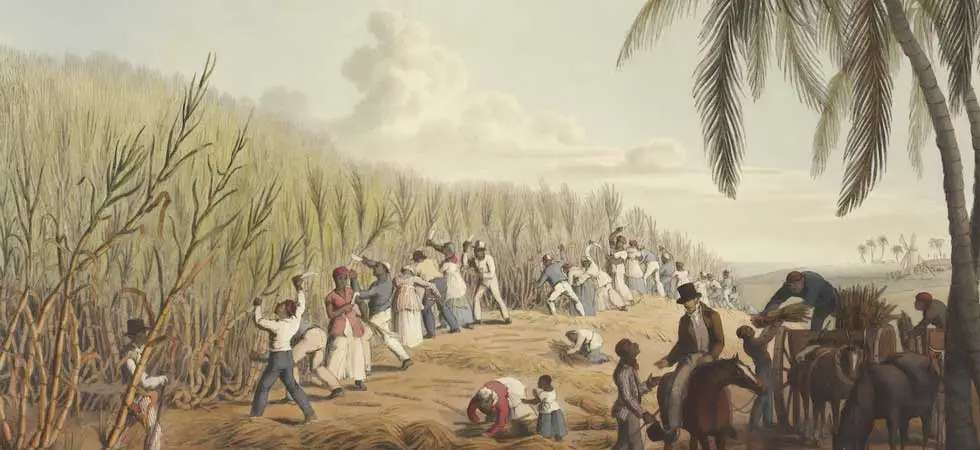▶ Slavery In America

Slavery In America

According to historical sources, the era of American slavery started in 1619 when a ship with 20 captives arrived at Point Comfort, which is now known as Fort Hampton in Virginia. In 1620, about 102 passengers arrived on the Mayflower. Most of the people enslaved in the New World were from West-Central Africa.
In the 1770s, slavery was a legal institution in almost half of America. At that time, an enslaved person was treated as property under the law and could be sold, purchased, or given away. Over 470,000 African slaves were brought to the American colonies between 1626 and 1860.
By 1860, the US census recorded that there were almost 4 million enslaved black people. To justify the exploitation of the blacks, white European Americans created a “scientific” doctrine of white superiority and black inferiority.
Thomas Jefferson, who was a slave owner, concluded that blacks were inferior to whites in terms of physical and mental qualities.
Abolition Of Slavery
The fight against slavery in America was a tough one. Eight of the first twelve presidents were slave owners. So, for decades, slave owners fought against the abolition of slavery in the United States.
By 1805, some forms of slavery had been abolished in all Northern states, but human smuggling practices continued till the late 1840s and that was because the nation depended on slave labor for rice and tobacco cultivation.

Some of America’s past revolutionary leaders feared that abolishing slavery would harm the states’ fragile union. However, Benjamin Franklin was willing to take that risk, so he signed a petition requesting Congress to abolish slavery in the United States. On March 2, 1807, The Act Prohibiting Importation of Slaves was enacted and it took effect on January 1, 1808.
Slave owners in the Upper South emancipated their slaves, while philanthropists purchased and freed others. In 1863, President Abraham Lincoln issued The Emancipation Proclamation, which liberated all United States slaves in states that had seceded from the Union, except those in Confederate territory already under the control of the Union army. The next was the 13th Amendment to the U.S. Constitution, outlawing slavery.
Although the 13th Amendment abolished slavery, emancipated black Americans experienced racism. The 14th Amendment granted citizenship and equal protection to previously enslaved men and women, while the 15th Amendment granted them the right to vote.
The Reconstruction Era was marked by federal legislation, such as the Civil Rights Act of 1866 and the Civil Rights Act of 1875.
They were made to protect the rights of former slaves. Despite all these provisions in the U.S. Constitution, the rights of blacks were frequently ignored or violated. White supremacists had control in most Southern states.
They went as far as creating terrorist organizations such as the Ku Klux Klan, White League, and the Red Shirts to frustrate African Americans.
The Practice Of Slavery In Modern Times

A photograph that shows whipping scars on Gordon, a former slave.
Even though slavery has been prohibited worldwide, it continues to raise its ugly head in our society. In 2017, a global joint study conducted by the United Nations International Organization for Migration, Walk Free Organization, and the United Nations International Labor Organization, revealed that about 40 million people are trapped in modern forms of slavery around the world.
In the same year, CNN aired footage of black African migrants who were auctioned in a clandestine market outside of Tripoli.

Poverty is the major reason why people get trapped in modern slavery. According to a 2018 report by the Global Slavery Index, over 403,000 individuals are living in modern-day slavery in the United States, and 80% of them are women and children.
Forms of modern slavery are human trafficking, forced labor, debt bondage, forced or early marriage, etc.
Every day, innocent people are trafficked from around the world to the United States, and upon arrival, they are forced to work their asses off without any good pay. Some people work for years without getting paid and are usually threatened with deportation.
Sadly, those who fell into these oppressive traps were people who left their countries, hoping to find greener pastures.
I read the story of Mr. Sunday Iaborot, a young African who left his country in 2016 with the plan of migrating illegally to Europe. After traveling through the trackless desert plains of Niger, he was captured immediately after he arrived in Libya and sold as a slave for as low as $200.
His masters imprinted a slave mark on his face and forced him to work without pay. His experience was terrible.
Slavery In America – Conclusion:
Freedom is a fundamental human right. Eradicating modern slavery can’t be achieved by the government alone. However, if all hands are put on deck, then dismantling the systems that enable exploitation and untangling enslaved people is an achievable goal.
While decision-makers are creating major laws against exploitative practices, individuals must endeavor to protect themselves, too. Many people became victims of slavery ignorantly.
To avoid that, there should be massive sensitization in rural and urban settlements. Also, victims of forced labor and human trafficking should be encouraged to speak out and the perpetrators must be brought to book.
Sources:
https://www.nps.gov/subjects/civilrights/rekindlingcivilrights.htm
https://en.wikipedia.org/wiki/Civil_rights_movement_(1896%E2%80%931954)










